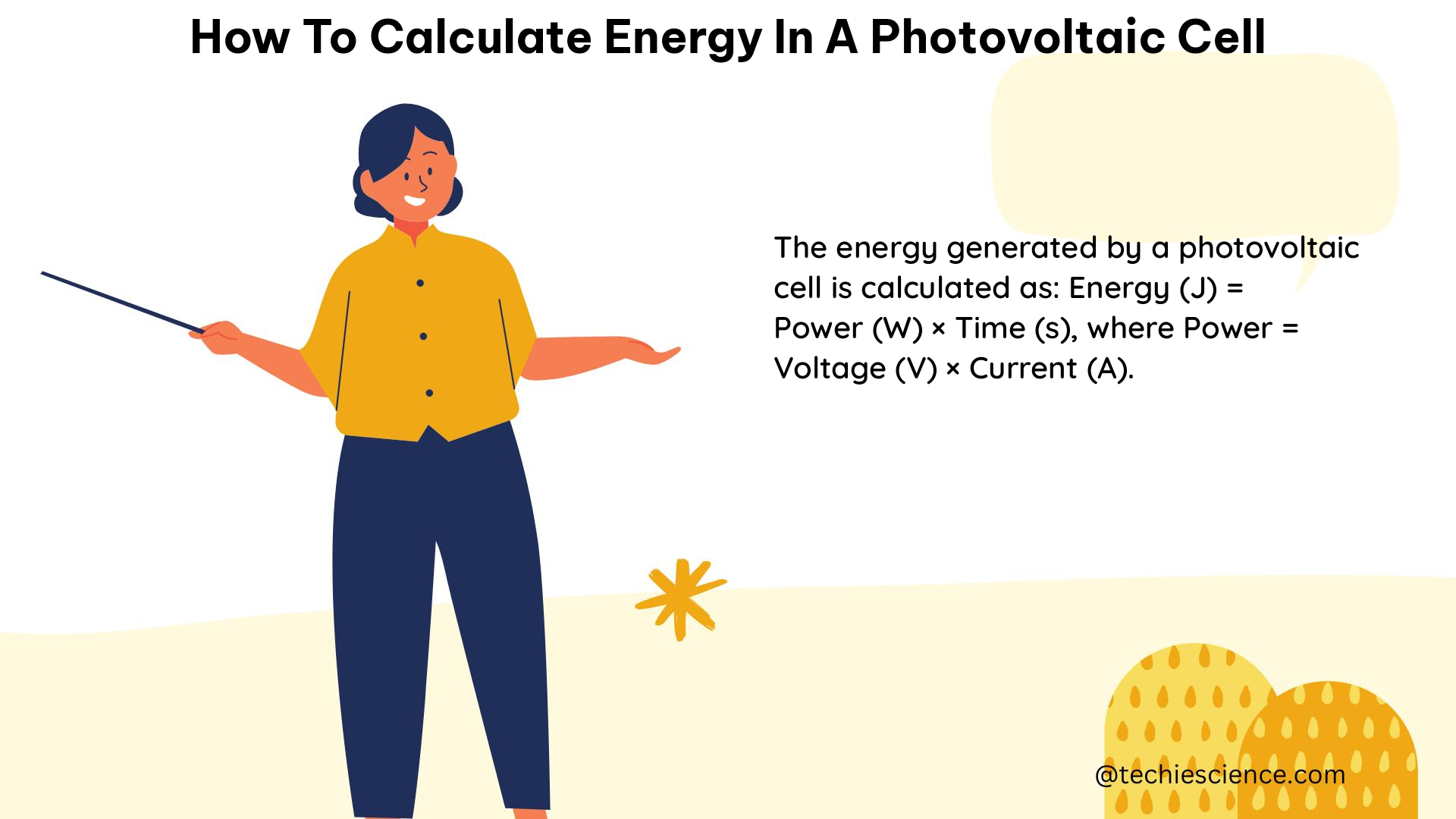Calculating the energy produced by a photovoltaic (PV) cell is a crucial step in understanding the performance and efficiency of solar energy systems. This comprehensive guide will walk you through the essential factors, formulas, and examples to help you accurately determine the energy output of a PV cell.
Understanding the Factors Affecting PV Cell Energy Output
To calculate the energy produced by a PV cell, we need to consider several key factors:
- Cell Area (A): The total surface area of the PV cell, measured in square meters (m²).
- Cell Yield (r): The ratio of the electrical power (in kilowatts peak, kWp) of one solar panel to the area of that panel, measured in kWp/m².
- Annual Average Solar Radiation (H): The amount of solar radiation incident on the tilted PV panels, measured in watts per square meter (W/m²).
- Performance Ratio (PR): A coefficient that accounts for various losses in the PV system, ranging from 0.5 to 0.9 (default value = 0.75).
The Energy Calculation Formula

The formula to calculate the energy produced by a PV cell is:
E = A * r * H * PR
Where:
– E is the energy produced by the PV cell, measured in kilowatt-hours (kWh)
– A is the total area of the PV cell, measured in square meters (m²)
– r is the yield of the PV cell, measured in kilowatts peak per square meter (kWp/m²)
– H is the annual average solar radiation on tilted panels, measured in watts per square meter (W/m²)
– PR is the performance ratio, a dimensionless coefficient
Calculating the Cell Yield (r)
The cell yield (r) is a crucial parameter in the energy calculation, as it accounts for the PV cell’s performance regardless of its orientation or tilt. The cell yield is typically provided by the manufacturer and is expressed as the ratio of the electrical power (in kWp) of one solar panel divided by the area of that panel.
For example, if a solar panel has a rated power of 300 Wp and an area of 2 m², the cell yield would be:
r = 300 Wp / 2 m² = 0.15 kWp/m²
Determining the Annual Average Solar Radiation (H)
The annual average solar radiation (H) on tilted panels can be obtained from weather data or calculated using solar radiation models. This value represents the amount of solar energy incident on the PV cell’s surface over the course of a year, and it is measured in watts per square meter (W/m²).
Some common sources for this data include:
– Local meteorological stations
– Solar radiation maps or databases (e.g., NREL’s National Solar Radiation Database)
– Solar radiation calculation tools (e.g., PVWatts Calculator)
Determining the Performance Ratio (PR)
The performance ratio (PR) is a dimensionless coefficient that accounts for various losses in the PV system, such as:
– Inverter efficiency
– Wiring losses
– Shading
– Soiling
– Temperature effects
– Other system-related losses
The PR typically ranges from 0.5 to 0.9, with a default value of 0.75. The manufacturer or system designer can provide the specific PR value for a given PV system.
Example Calculation
Let’s consider a PV cell with the following characteristics:
– Area (A): 1.5 m²
– Yield (r): 0.15 kWp/m²
– Annual Average Solar Radiation (H): 1,500 W/m²
– Performance Ratio (PR): 0.75
Using the energy calculation formula, we can determine the energy produced by this PV cell:
E = A * r * H * PR
E = 1.5 m² * 0.15 kWp/m² * 1,500 W/m² * 0.75
E = 1.5 * 0.15 * 1,500 * 0.75
E = 168.75 kWh
Therefore, this PV cell would produce approximately 168.75 kWh of energy per year.
Advanced Considerations
For more complex PV systems or specific applications, there are additional factors and considerations that may need to be taken into account, such as:
– Shading and partial shading effects
– Tilt and orientation of the PV panels
– Temperature coefficients and their impact on efficiency
– Degradation rates and long-term performance
– Tracking systems and their influence on energy production
These advanced topics are beyond the scope of this introductory guide, but they can be explored further through specialized resources and literature.
Conclusion
Calculating the energy produced by a photovoltaic cell is a crucial step in understanding the performance and efficiency of solar energy systems. By considering the key factors of cell area, yield, solar radiation, and performance ratio, you can accurately determine the energy output of a PV cell using the provided formula. This comprehensive guide has provided you with the necessary knowledge and tools to perform these calculations, empowering you to make informed decisions and optimize your solar energy projects.
References
- Procedure for Measuring and Reporting the Performance of Photovoltaic Systems, NREL, https://www.nrel.gov/docs/fy06osti/38603.pdf
- Understanding Solar Photovoltaic System Performance, U.S. Department of Energy, https://www.energy.gov/sites/default/files/2022-02/understanding-solar-photo-voltaic-system-performance.pdf
- Analysis of Photovoltaic System Energy Performance Evaluation Methods, NREL, https://www.nrel.gov/docs/fy14osti/60628.pdf

The lambdageeks.com Core SME Team is a group of experienced subject matter experts from diverse scientific and technical fields including Physics, Chemistry, Technology,Electronics & Electrical Engineering, Automotive, Mechanical Engineering. Our team collaborates to create high-quality, well-researched articles on a wide range of science and technology topics for the lambdageeks.com website.
All Our Senior SME are having more than 7 Years of experience in the respective fields . They are either Working Industry Professionals or assocaited With different Universities. Refer Our Authors Page to get to know About our Core SMEs.